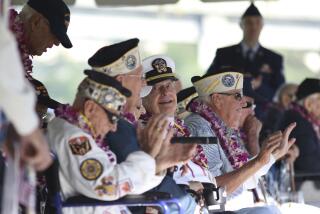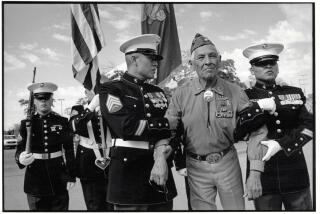Review: ‘Target Tokyo’ brings a well-known WWII story back to life
After Pearl Harbor and before D-day and the Bomb, there was the Doolittle raid on Tokyo.
President Franklin D. Roosevelt, hoping to rally the American public for what he knew would be a long war, had ordered a swift retaliation for the attack of Dec. 7, 1941. And so, on April 18, 1942, 16 B-25s launched from the carrier Hornet for a long-distance bombing raid on Tokyo and other Japanese cities. B-25s had never launched from a carrier; they would make the raid without fighter escort.
The raid quickly became one of the most storied military missions of World War II, with enormous press coverage and, in 1944, a movie based on the true events starring Spencer Tracy as Jimmy Doolittle. Since the war, the raid and the men who flew it have been chronicled in books, documentaries and newspaper feature stories.
Now comes James M. Scott’s marvelous new book, “Target Tokyo: Jimmy Doolittle and the Raid That Avenged Pearl Harbor,” deeply reported and with a strong narrative style.
It is undoubtedly the most comprehensive account yet of the training of the crew, the modification of the planes, the air attack itself and the complex aftermath in Japan, the U.S. and China. In Scott’s hands, the story, even at 480 pages (not including footnotes), remains a page-turner. To gather material, Scott visited three dozen archives on four continents.
The raid led by Lt. Col. Jimmy Doolittle was a boost to sagging American morale. If the Americans were buoyed, the Japanese were stunned: the raid punctured the Japanese militarists’ claim that no invader could reach their island.
Both sides made exaggerated claims: The Americans said the damage was much greater than it was and that none of the planes had been lost (not true). The Japanese said the Americans had targeted civilians (not true, but there were civilian casualties) and that several planes had been shot down (not true).
In both countries, the raid rallied the public to the government: “Just as Roosevelt had capitalized on the mission’s success to help bolster American morale, the Japanese used the attack to outrage and unite the rattled public.”
Eight of the 80 airmen were captured by the Japanese in China. Three were executed and one starved to death in a Japanese prison. The Americans were tortured by waterboarding. Japanese claimed that aviators had confessed to deliberately targeting civilians, according to Scott.
The raid pushed the Japanese military into the foolhardy decision to attempt an invasion of Midway to increase the protective zone for the home islands. The Japanese defeat at Midway proved to be a turning point.
In China, Japanese troops launched a barbarous campaign to find the Americans whose planes, out of gas, had crashed there; an estimated 250,000 Chinese were slaughtered, villages and cities were razed, women were raped.
The bravery and sacrifice of the Chinese and a group of Western missionaries who rescued the airmen and helped guide them to safe areas where U.S. and Chinese forces were located is one of the unknown — or at least lesser known — parts of the Doolittle raid. Scott covers it in riveting detail.
Another is the odyssey of the airmen whose plane landed safely in Vladivostok (against Doolittle’s orders). The Russians were supposedly U.S. allies. But months of black bread, vodka, boredom and uncertain house arrest lay ahead for the Americans.
Most of the 80 airmen were back in the U.S. within months of the raid, including Doolittle, promoted to general and awarded the Medal of Honor. Scott captures the civilian fervor that gripped the nation. Never a shy man, Doolittle knew the value of celebrity in supporting the war effort on the homefront.
Doolittle spoke to 12,000 workers and guests at an aircraft factory in Inglewood where the B-25s had been built. U.S. officials were keeping secret the fact the planes had launched from a carrier (although the Japanese already knew); FDR told reporters the planes were from a base he called Shangri-La.
“Don’t tell a soul, but Shangri-La is right here at this North American plant,” Doolittle told the workers. “Our bombers — your bombers — functioned magnificently.”
Any story as complex as the Doolittle raid will have facts that do not seem to fit the narrative. It is to Scott’s credit that “Target” does not shy from those facts. While he is unstinting in his description of Japanese savagery, he provides a touching account of the day that Lt. Dean Hallmark, Lt. William Farrow and Cpl. Harold Spatz were executed by a Japanese firing squad.
The prison warden, Sotojiro Tatusta, was one of the witnesses, Scott reports. The three airmen were tied to crosses. Tatusta reminded the three that Christ died on a cross. Your names will live forever, he said.
“When you are executed — when you die on the cross, you will be honored as Gods,” he said.
As gods perhaps not, but, as Scott reports, as brave young Americans at a time when their country desperately needed bravery.
Target Tokyo
Jimmy Doolittle and the Raid That Avenged Pearl Harbor
James M. Scott
W.W. Norton: 648 pp, $35
More to Read
Sign up for our Book Club newsletter
Get the latest news, events and more from the Los Angeles Times Book Club, and help us get L.A. reading and talking.
You may occasionally receive promotional content from the Los Angeles Times.






